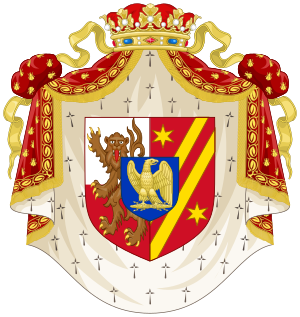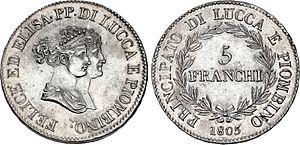Elisa Bonaparte facts for kids
Quick facts for kids Elisa Bonaparte |
|||||
|---|---|---|---|---|---|
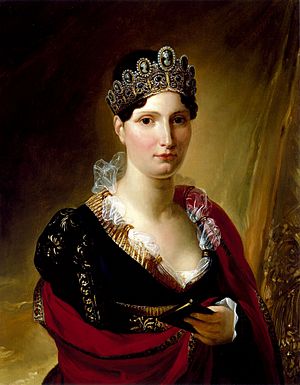
Portrait by Joseph Franque, 1812
|
|||||
| Grand Duchess of Tuscany | |||||
| Reign | 3 March 1809 – 1 February 1814 | ||||
| Predecessor | Charles II, Duke of Parma | ||||
| Successor | Ferdinand III, Grand Duke of Tuscany | ||||
| Princess of Lucca and Piombino | |||||
| Reign | 19 March 1805 – 18 March 1814 | ||||
| Predecessor | Antonio I Boncompagni-Ludovisi as Prince of Poimbino | ||||
| Successor | Maria Luisa as Duchess of Lucca Felice Boncompagni-Ludovisi as Prince of Poimbino |
||||
| Born | Maria Anna Buonaparte 3 January 1777 Ajaccio, Corsica, France |
||||
| Died | 7 August 1820 (aged 43) Trieste, Austrian Empire |
||||
| Burial | San Petronio, Bologna | ||||
| Spouse |
Felice Pasquale Baciocchi
(m. 1797) |
||||
| Issue | Felix Napoléon Baciocchi Elisa Napoléone Baciocchi Jérôme Charles Baciocchi Frédéric Napoléon Baciocchi |
||||
|
|||||
| House | Bonaparte | ||||
| Father | Carlo Buonaparte | ||||
| Mother | Letizia Ramolino | ||||
| Religion | Roman Catholicism | ||||
Elisa Bonaparte (born Maria Anna Bonaparte; 3 January 1777 – 7 August 1820) was an important French princess. She was the older sister of Napoleon Bonaparte, a famous French emperor. Elisa was the fourth child and oldest daughter of Carlo Buonaparte and Letizia Ramolino.
She held a lot of power during her time. She was the Princess of Lucca and Piombino from 1805 to 1814. Later, she became the Grand Duchess of Tuscany from 1809 to 1814. She was the only sister of Napoleon to have real political power. Elisa was very interested in the arts, especially theater. She supported artists and plays in the areas she ruled.
Contents
Elisa Bonaparte's Early Life
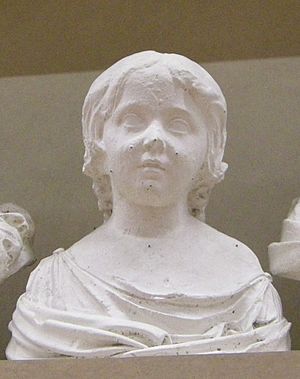
Elisa was born in Ajaccio, a city on the island of Corsica. Her birth name was Maria-Anna, but she later started using the name "Elisa." In 1784, she received a scholarship to attend a special school called the Maison royale de Saint-Louis near Paris. Her brother Napoleon often visited her there.
When the French Revolution began, the school closed in 1792. Elisa then returned to Ajaccio with Napoleon. Around 1795, her family moved to Marseille. There, Elisa met Felice Pasquale Baciocchi, a Corsican nobleman.
Marriage and Family Life
Elisa married Felice Pasquale Baciocchi in 1797. They had a civil ceremony in Marseille and a religious one in Mombello. Napoleon had some worries about Felice, as he was not a very successful military captain. Elisa's sister, Pauline Bonaparte, also got married on the same day.
In 1799, the Bonaparte family moved to Paris. Elisa hosted parties and put on plays at her home. She also became good friends with a journalist named Louis de Fontanes. When her brother Lucien's wife passed away in 1800, Elisa took care of his two daughters.
In 1804, France became the First French Empire. Elisa and her sisters were given the title "Imperial Highness." Her husband, Felice Baciocchi, was promoted to general and became a senator.
Princess of Lucca and Piombino
In 1805, Napoleon made Elisa the ruler of the Principality of Piombino. This area was important because it was close to Elba and Corsica. Elisa and Felice were given the titles "Prince and Princess of Piombino." Later that year, the Republic of Lucca was also added to their lands. They officially took control of Lucca on July 14, 1805.
Napoleon called Lucca the "dwarf republic" because it was so small. However, it was an important place for politics and trade. Elisa held most of the power in Lucca and Piombino. Felice mostly handled military matters. The people of Lucca were not happy about losing their independence. They called Elisa "la Madame" and did not like the French influence.
Elisa was very active in running her territories. She worked with ministers who stayed with her throughout her rule. She also created a royal court with rules similar to Napoleon's court in Paris.
In 1806, Napoleon added Massa and Carrara to Elisa's lands. Carrara was famous for its white marble. Elisa wanted to make Carrara a center for art. She started an Académie des Beaux-Arts to train sculptors. She also created the Banque Élisienne to help artists and workers financially.
Elisa made many changes to the laws and public services. She reformed the local religious groups and took control of some of their lands. She also introduced new laws based on the Napoleonic Code. In 1807, she created a "Committee of Public Charity" to help the poor. She also started free medical care to fight diseases.
She built a new hospital in Piombino and a health center in the port. Elisa also encouraged farming and trade. She started a committee to find new ways to improve agriculture. For example, she promoted growing mulberries for silk production.
Elisa also focused on education. In 1809, she created a "General Department of Public Education." She opened the "Collège Félix" for boys in 1807. For girls, she set up rules for schools in convents. She also made teaching compulsory for girls aged 5 to 8. In 1807, she founded the "Institut Élisa" for noble girls. Later, she opened a school for poor girls in 1812.
Elisa also started many building projects. She expanded the princely palaces in Lucca. This meant tearing down some old buildings, which made some people upset. She also improved the gardens and built a botanical garden. She started building new roads and an aqueduct for Lucca, but these were finished after her rule ended.
Grand Duchess of Tuscany
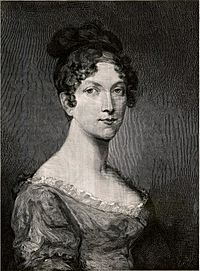
In 1807, Napoleon took control of Tuscany and made it part of France. In 1809, he officially made Tuscany a Grand Duchy with Florence as its capital. Elisa became the "grand duchess" of Tuscany. However, she had less freedom here than in Lucca. She had to follow Napoleon's orders and could not change them. Her husband, Felice, was also promoted to a higher general rank.
Elisa was the only woman Napoleon trusted with real political power. He usually did not like women involved in politics. He once said about her: "My sister, Elisa, has a masculine mind, a forceful character, noble qualities and outstanding intelligence; she will endure adversity with fortitude."
Elisa arrived in Florence in April 1809. She was not welcomed warmly by the local nobles. Her arrival happened during a protest against forced military service. This protest ended after a mayor and a judge were killed. The forced military service and new taxes made many people in Tuscany unhappy. Like in Lucca, Elisa tried to take control of church property.
She continued to support arts and science. She ordered a sculptor to create statues of her family. She also supported the Imperial Museum of Physics and Natural History in Florence.
Elisa became involved in Napoleon's conflict with Pope Pius VII. The Pope did not want Napoleon to take over the Papal States. He even spoke out against Napoleon. In response, Napoleon had the Pope removed from Rome in July 1809. The Pope passed through Florence, and Elisa asked him to leave quickly. She did not want to upset Napoleon by seeming to support his enemy.
Elisa's relationship with Napoleon became difficult. Napoleon often criticized her for not following his orders exactly. He demanded money from her territories. When Elisa refused to pay a second time, Napoleon threatened to take away her lands. He also demanded that Lucca provide soldiers, which it had not had to do before. These demands made Elisa less popular in Lucca.
Elisa Bonaparte's Fall and Exile
In 1813, Napoleon was losing battles against other European countries. Elisa's brother-in-law, Joachim Murat, who was King of Naples, joined Napoleon's enemies. He marched his army to Florence in 1814. Elisa had to leave Tuscany and flee to Lucca.
In March, British and Austrian forces captured Lucca. Elisa, who was pregnant, had to escape on the night of March 13, 1814. She was forced to give up her title as Grand Duchess of Tuscany. The old ruler, Grand Duke Ferdinand III, returned to power.
Elisa tried to find a place to live in Italy and France, but her requests were denied. Finally, she was allowed to stay in Austria. She moved to a house in Trieste. Napoleon was sent away to the island of Elba. Elisa was arrested in March 1814 and held in an Austrian fortress.
She was released in August and allowed to live in Trieste. She was given the title "Countess of Compignano." Elisa bought a country house and helped with archaeological digs. In June 1820, she became ill, possibly at an excavation site. She died on August 7, 1820, at the age of 43. Elisa was the only adult sibling of Napoleon who did not live longer than him. She was buried in the San Petronio Basilica in Bologna.
Marriage and Children
Elisa married Felice Pasquale Baciocchi Levoy on May 1, 1797. Felice was a nobleman from Corsica. They had five children:
- Felix Napoléon Baciocchi Levoy (1798–1799)
- Napoléon Baciocchi (1803-1803)
- Elisa Napoléone Baciocchi Levoy (1806–1869); she married Philippe, Comte Camerata-Passioneï de Mazzoleni. They had one son:
- Charles Félix Jean-Baptiste Camerata-Passionei di Mazzoleni (1826–1853)
- Jérôme Charles Baciocchi Levoy (1810–1811)
- Frédéric Napoléon Baciocchi Levoy (1814–1833)
Images for kids
-
Portrait with her daughter Elisa by François Gérard, 1811
See also
 In Spanish: Elisa Bonaparte para niños
In Spanish: Elisa Bonaparte para niños


